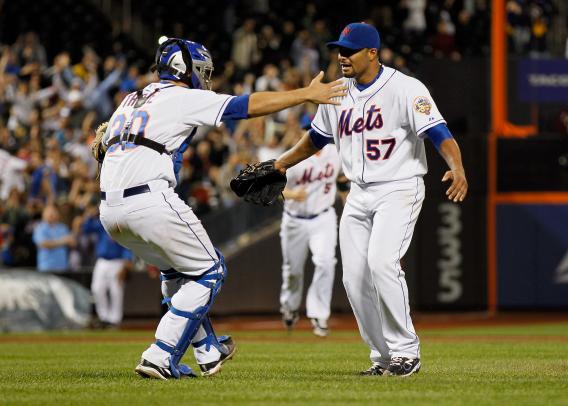“FINALLY THE FIRST ONE” blares the NBC Sports headline in all-caps. “The 8020th Time’s a Charm” the Wall Street Journal proclaimed. “Some things in sports defy logic,” said baseball analyst Jayson Stark on SportsCenter, “defy what you think is possible.”
Sportswriters have hyped the Mets’ no-hitter-less streak as “one of the most hilarious streaks in sports” and “one of the most notorious droughts in baseball history.” But are 50-plus seasons without a no-hitter really that out of the ordinary? How does it compare to other baseball streaks?
Johan Santana’s no-hitter is certainly remarkable—but not for the reasons the sports media are citing today. It’s noteworthy because a no-hitter itself is incredibly rare—not as rare as a four home run game, hitting for the cycle, or an unassisted triple play, but infrequent enough that a team can fairly easily go decades without one. Such a streak, in fact, isn’t statistically that improbable.
Since 1962, the year the Mets first suited up, there have been 213,422 starts by major league pitchers. During that span, there have been 131 no-hitters, giving the proportion of pitchers tallying a zero in the hit column for nine innings at .000614 (or .0614 percent). To calculate the Mets’ chances of going 8019 games without such a game, merely take the odds of NOT throwing a no-hitter (1 – 0.000614, or 0.999386) and put it to the power of 8019, the number of games the Mets played before Santana’s gem. This comes out to 0.0073, which means there was about a 0.73 percent chance of a streak of such length occurring.
Another method of calculating the probability of such a streak is to find the mean and standard deviation in no-hitters since 1962 of every franchise that has been in existence since that time. Those teams have had an average of 5.55 no-hitters, and the standard deviation is 2.502. The Mets’ big squadoosh only places them 2.22 standard deviations below the mean, or in the 1.3 percentile.
Fortuitously, an applications developer at Bloomberg Sports conducted a study on the Mets’ streak just five days ago, and his conclusions were published by Baseball Prospectus. He arrived at slightly lower figures. But whatever metric one uses, the odds of such a lengthy streak occurring hover around 1 percent. Which makes such a drought unexpected, to be sure, but perhaps not quite worthy of the Tebow and Lin-esque frenzy with which the dry spell has been covered. Is a 1-in-100 event really that remarkable?
Consider that such a streak is not unprecedented—it’s not even the longest in league history. The Phillies went 8,945 games without a no-hitter from 1909 to 1964, easily besting the Mets’ drought. The Cubs have gone nearly as many games without being the victims of a no-hitter: It has been 7,421 games since Sandy Koufax no-hit them in 1965. Just in this decade, there were 6,364 major league games played between Randy Johnson’s perfect game in 2004 and the next no-hitter by Anibal Sanchez in 2006.
There have been many truly unlikely streaks in baseball. Orel Hershiser’s 59-inning scoreless streak for the Dodgers in 1988. Bill Bergen’s 46 consecutive at-bats without a hit in 1909. And, of course, Joe DiMaggio’s 56-game hitting streak in 1941. (According to one study, DiMaggio would likely have gone 18,519 years before he could expect another streak of such length.) Of course, Hershiser, Bergen, and DiMaggio were all significantly above or below average players who entered each at-bat or inning with a higher probability of keeping their streak alive than the average player. But even if you factor in more extreme averages or ERAs for the individual streaks, the odds of them occurring are still many orders of magnitude lower than the Mets’ mundane no-hitter drought odds.
The media should celebrate Santana’s accomplishment, of course. What he did was, on an individual, extremely rare and impressive. The relatively tame, 8,019-game anomaly that preceded it, however, is not that remarkable.
